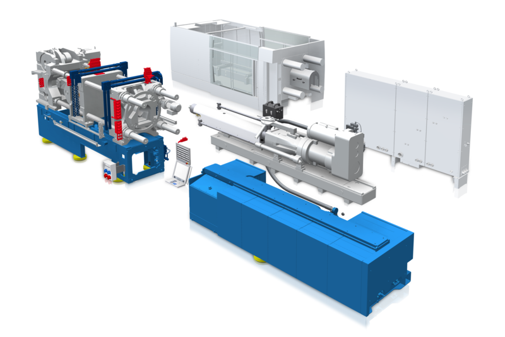Injection molding is manufacturers' preferred choice when it comes to mass production due to its simplicity and repeatability. But did you know that copper-based alloys are key in speeding up the cycle times, thus significantly improving productivity?
What do Lego bricks, car bumpers, PET bottles, and medical syringes have in common? Well, all of these products are typically produced by injection molding. No wonder the global injection molded plastics market is booming. In 2021, it was valued at 284.7 billion dollars – and thanks to the growing demand for plastic components, the market is expected to expand even further. Annual growth of 4.2 % can be expected from 2022 – 2030 as various end-use industries, including automotive, packaging, and healthcare, drive the market.
But what exactly makes this manufacturing process so popular in demand? Modern innovations have established plastic injection molding as the method of choice in the mass production of plastic parts. For example, using copper-based alloys can help reduce production cycles by up to 80 %. Time to take an in-depth look at the injection molding process.
What is injection molding?
Injection molding is a great manufacturing process, which is especially well suited for mass production where the same part is being created thousands or even millions of times in succession. Any parts produced in large volumes made of glass, rubber, metal, or plastic are typically created through injection molding. Although injection molding can be performed with multiple materials, we are here to cover the topic of plastic injection molding.
 Image: Schematic view of an injection molding machine
Image: Schematic view of an injection molding machine
There are multiple reasons why plastic injection molding is known as one of the most common and efficient manufacturing processes there is. One of which is its high efficiency: Typically, the cycle time is between 15 seconds and 2 minutes, depending on the part's complexity. This fast production makes it incredibly valuable for mass production.
Furthermore, the process allows for high complexity, offers a very low rejection rate of under one percent, and produces virtually no waste as excess plastic is ground up, recycled, and reused.
The cycles of the injection molding process
The injection molding process is divided into four stages, all combined and resulting in one cycle.
These stages are:
- Clamping
A mold comprises two parts: the cavity and the core. Both halves have to be closed before the injection starts. Therefore, a clamping unit is used to push the cavity and the core together. Now it is time for the injection.
- Injection
Plastic pellets are fed through a hopper. As the pellets move toward the mold, the heat surrounding the barrel combined with the pressure melts the pellets. The now molten pellets are injected into the mold in a matter of milliseconds. Time to chill.
- Cooling
After the plastic is injected, it needs to cool down, harden and finally take the desired shape. The mold can only be opened once the cooling process has finished. The cooling time highly depends on the plastic used, the design of the shape, and the heat dissipation properties of the mold material. We will come back to this later on.
- Ejection
Once the plastic has cooled, the mold opens, and an ejection system pushes out the finished plastic part. After the part is ejected, the mold is ready for the next cycle and can be shut again.
Use of copper-based alloys in injection molding
Copper is well-known for its heat conductivity, among other valuable properties. As copper by itself lacks the necessary strength to serve as an injection mold, experienced metallurgists have found a solution by developing copper-based alloys that attain strength and hardness while maintaining much of its conductivity.
 Image: Core part made of AMPCOLOY® 940 for the production of plastic buckets
Image: Core part made of AMPCOLOY® 940 for the production of plastic buckets
Aluminum bronze is a prime example: Thanks to its excellent heat transfer properties, aluminum bronze speed up the cooling phase drastically, leading to reduced cycle times and increased productivity up to 80%.
Beryllium bronze – premium solution for faster cycle times!
And even though aluminum bronze is already a great solution, the premium solution for injection molding is beryllium bronze. These alloys combine good strength, wear resistance, high-temperature resistance, and high toughness with excellent conductivity. That is why beryllium bronze is widely used in plastic injection molding mold inner inserts, cores, die-casting punches, and many more.
AMPCOLOY® 83 is such a beryllium bronze. For example, in the mass production of beverage bottles, cores made of AMPCOLOY® 83 serve as heat conductors. The heat is removed directly from the cavity through the AMPCOLOY® 83 core to the cooling channel.
Want to learn more about plastic injection molding and why copper-based alloys are the right choice for your plastic tooling operations? Download our free technical paper «A Rookies Guide to injection molding - How copper alloys add direct value to the plastic industry» now.



.png?width=250&name=download-1500x1435%20(10).png)

